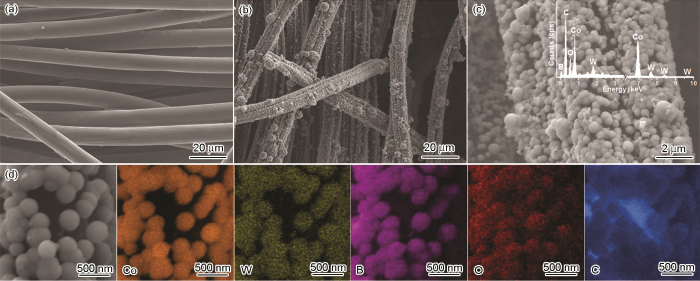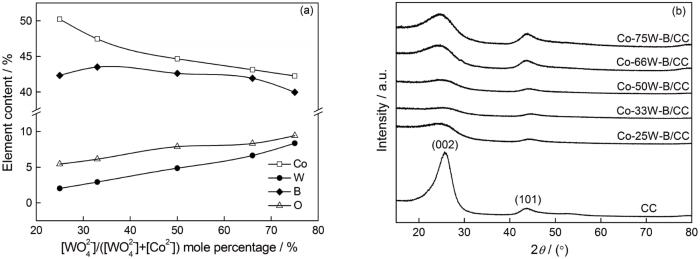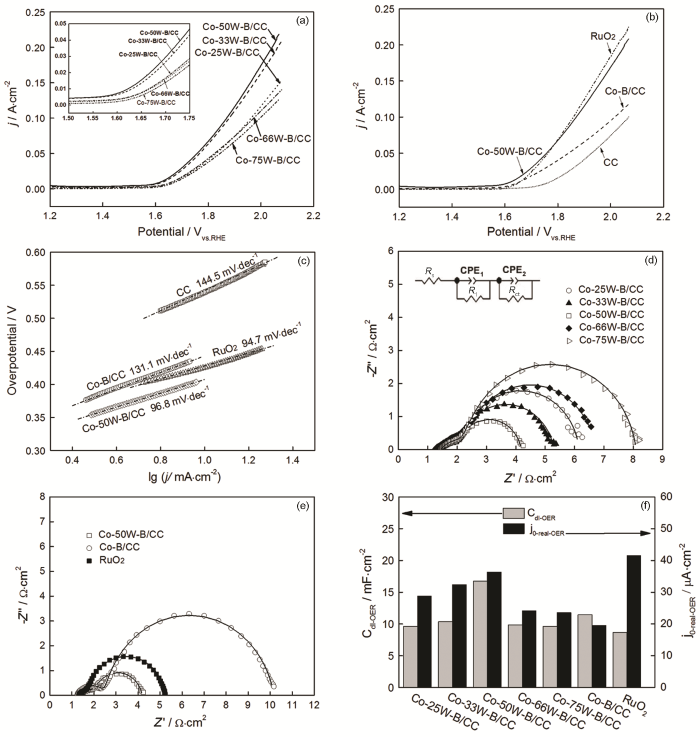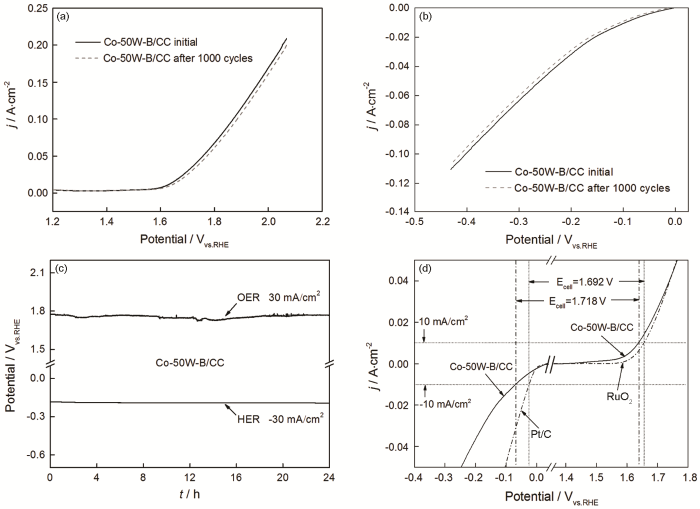1 实验方法
1.1 Co-W-B/CC复合电极材料的制备
通过湿化学还原将Co-W-B催化活性物质沉积在1cm×1cm的碳布(CC)上。先在浓硫酸和浓硝酸(VH2SO4:VHNO3=3:1)的混合液中对CC进行活化处理,分别用去离子水、无水乙醇超声清洗后自然干燥。
配制溶液A:将CoCl2·6H2O和Na2WO4·2H2O溶入去离子水,控制[Co2+]+[WO42-]=0.3 mol/L,用氨水调节pH值为10。配制溶液B:将NaBH4和NaOH溶入去离子水,NaBH4为1.0 mol/L,NaOH为0.25 mol/L。将一定体积的溶液A置入冰水浴,然后将活化处理过的CC浸泡在溶液A中并施加超声波震荡。另取相同体积的溶液B逐滴加入到溶液A中,然后维持反应60 min。最后,将得到的Co-W-B/CC样品取出,用去离子水洗净后放入60℃的真空干燥箱中进行干燥。
通过改变溶液A中WO42-的摩尔浓度占比(χW%=[WO42-]/([WO42-]+[Co2+])×100%,χW%=0%、χW%=25%、33%、50%、66%、75%)调节Co-W-B中的Co、W元素比例。将不同Co、W元素比例的样品记为Co-χW-B/CC(χW%=0%时,即Co-B/CC)。用增重法测得不同Co-W-B在CC表面的沉积量均为~0.38 mg/cm2。作为对比,将0.38 mg的商用20wt.% Pt/C和RuO2用传统的涂覆方式分别负载在1 cm×1 cm的CC表面。
1.2 性能表征和电化学测试
用FESEM(Hitachi SU5000)、EDX(Oxford X-act)分别测试样品的表面形貌、元素种类、元素含量及分布状况。用XRD(Rigaku Ultimal Ⅳ)测试样品的物相和晶体结构。使用电化学工作站(Princeton VersaSTAT4)在25℃下1 mol/L NaOH溶液中对样品进行电化学测试。在三电极测试体系中,参比电极为Hg/HgO/OH-(1 mol/L)电极,对电极为2 cm2的碳棒电极,所制得的样品为工作电极,样品测试面积为1 cm2。本文所有电化学测试结果的电位值,均换算为相对于标准氢电极(RHE)。线性扫描伏安曲线(LSV)的扫描速率为5 mV/s,OER与HER测试过程的扫描电位区间分别为0.87~2.07Vvs.RHE和0.22~2.62Vvs.RHE;电化学阻抗谱(EIS)的测试频率范围为105~10-2 Hz,扰动电位幅值为5 mV。
2 结果和讨论
2.1 Co-W-B/CC复合电极材料的的表面形貌
图1
图1
CC和Co-50W-B/CC的SEM照片、(c-inset) Co-50W-B/CC的EDX能谱以及Co-50W-B/CC的表面元素分布
Fig.1
SEM image of CC (a); SEM images of Co-50W-B/CC (b, c)、(c-inset) EDX energy spectrum of Co-50W-B/CC and EDX-mapping of Co-50W-B/CC (d)
如图2a所示,当制备过程中随着χW%值从25%逐渐升至75%沉积物中Co元素含量不断降低,W元素含量不断升高,B元素含量(原子分数)则在39.9%~43.6%内波动。由于BH4-难以将WO42-还原为零价W,产物中的W元素一般以其低价态氧化物的形式存在[14]。因此,EDX分析结果表明,各样品中均存在O元素且伴随W元素含量的提高O元素的含量也呈上升趋势。图2b给出了CC和不同Co-W-B/CC样品的XRD衍射图谱。在CC样品的图谱中,23.8°和44°附近的衍射峰分别对应C(JCPD file#08-0451)的(002)及(101)晶面。五种Co-W-B/CC样品也只在23.8°和44°附近出现衍射峰,短时其强度比CC样品显著降低且漫散射信号加强,意味着这些Co-W-B沉积物以非晶状态包覆CC表面形成。以往用类似反应制备Co-B或Ni-B粉体材料,其产物多为非晶态[17,18]。由图3可见,χW%值过高(χW%≥66%)时Co-W-B沉积物在CC表面分布不均,且沉积物的结构疏松,使其对CC的包覆程度降低。因此,Co-66W-B/CC和Co-75W-B/CC样品的C衍射峰强度明显高于其他样品。
图2
图2
χW%值([WO42-]/([WO42-]+[Co2+])摩尔百分比)对Co-W-B催化活性物质中元素含量的影响和 CC以及不同Co-W-B/CC样品的XRD衍射图谱
Fig.2
Effect of the χW% ([WO42-]/([WO42-]+[Co2+]) mole percentage) on the content of elements in Co-W-B (a) and XRD patterns of CC and Co-W-B/CC samples(b)
图3
图3
Co-66W-B/CC和Co-75W-B/CC的SEM照片
Fig.3
SEM image of Co-66W-B/CC (a) and Co-75W-B/CC (b)
2.2 Co-W-B/CC复合电极材料的电催化OER、HER活性及其机制
目前工业上实施的电解水工艺大都在碱性环境中进行[19],因此本文在1 mol/L NaOH溶液中分析Co-W-B/CC材料的电解水催化活性,包括阳极反应的OER过程和阴极反应的HER过程。
五种Co-W-B/CC样品OER过程的线性扫描伏安曲线(LSV),如图4a所示。随着制备过程中χW%值的提高样品的OER活性呈现先升后降的变化趋势,其中Co-50W-B/CC的OER活性最高。与CC、Co-B/CC和RuO2样品的LSV曲线(图4b)比较,Co-W-B/CC样品的OER活性均显著高于CC和Co-B/CC,其中Co-50W-B/CC的OER活性与RuO2接近,甚至在较低的电位区间超越了RuO2。阳极电流密度为10 mA/cm2时,不同样品的OER过电位(ηOER-10)分别为ηOER-10,CC=0.548 V、ηOER-10,Co-B/CC=0.462 V、ηOER-10,RuO2=0.432 V、ηOER-10,Co-25W-B/CC=0.438 V、ηOER-10,Co-33W-B/CC=0.406 V、ηOER-10,Co-50W-B/CC=0.394 V、ηOER-10,Co-66W-B/CC=0.441 V、ηOER-10,Co-75W-B/CC=0.457 V。
图4
图4
不同Co-W-B/CC样品的LSV曲线(嵌入图为1.50~1.75VvsRHE电位范围的局部放大图)、Co-50W-B/CC、CC、Co-B/CC和RuO2样品的LSV曲线、 Co-50W-B/CC、CC、Co-B/CC和RuO2样品的Tafel斜率、不同Co-W-B/CC样品和Co-50W-B/CC、Co-B/CC和RuO2样品的EIS曲线以及不同样品的Cdl-OER值和j0-real-OER值
Fig.4
OER process:LSV curves of Co-W-B/CC samples (the inset figure is the enlarged view of 1.50~1.75VvsRHE) (a), LSV curves of Co-50W-B/CC, CC, Co-B/CC and RuO2 (b), Tafel slopes of Co-50W-B/CC, CC, Co-B/CC and RuO2 (c), EIS plots of Co-W-B/CC samples (d), EIS plots of Co-50W-B/CC, CC, Co-B/CC and RuO2 (e),and Cdl-OER and j0-real-OER of samples (f)
Tafel斜率(Tafel曲线的线性极化区斜率)也能在一定程度上反映电极材料的催化活性[20]。Tafel斜率越低则电极反应速率(反应电流密度)随过电位增加而提升的幅度越大,意味着催化活性越高[21]。根据图4b计算出相应样品的Tafel斜率,画在图4c中。可以看出,Co-50W-B/CC的Tafel斜率为96.8 mV/dec,比CC(144.5 mV/dec)和Co-B/CC(131.1 mV/dec)大幅降低,只比RuO2(94.7 mV/dec)高约2.2%,再次说明Co-50W-B/CC的OER活性与RuO2接近。此外,相近的Tafel斜率还表明,Co-50W-B/CC与RuO2两者表面发生OER过程的反应动力学机制类似[22]。
在阳极过电位为0.6 V的条件下测定了不同样品的电化学阻抗谱(EIS),如图4d和4e所示。EIS曲线均有两个容抗弧,表明各样品表面的电极过程有两个时间常数,其中弦长较小的高频容抗弧与电极表面的微观孔隙有关,弦长较大的中-低频容抗弧则与电荷转移过程相关[9]。图4d中的插图为表征电极过程的等效电路模型,其中Rs为溶液电阻,R1为孔隙电阻,Rct为电荷转移电阻,CPE1和CPE2为分别代表孔隙电容和双电层电容的恒相位角元件。根据对Rct值的比较,可判断电极表面法拉第过程的难易程度[23]。根据等效电路模型对EIS数据进行拟合,得出OER过程的Co-50W-B/CC的Rct值为2.24 Ω/cm2,几近于RuO2 (2.17 Ω/cm2),Co-B/CC (8.87 Ω/cm2)、Co-25W-B/CC (3.86 Ω/cm2)、Co-33W-B/CC (3.18 Ω/cm2)、Co-66W-B/CC (4.36 Ω/cm2)和Co-75W-B/CC(5.92 Ω/cm2)五种样品的Rct值则相对较高。这些结果表明,Co-50W-B/CC可有效促进OER过程中的界面电子转移,加速反应的进行。
经EIS数据拟合得到的OER过程的双电层电容(Cdl-OER),反映电极材料表面催化活性位点的多少[24]。根据图4a和b中的LSV曲线并结合Tafel关系式,可推算出不同样品OER过程的表观交换电流密度(j0-OER)。而OER过程的表观交换电流密度与其双电层电容的比值(j0-real-OER=j0-OER/Cdl-OER),则是表征电极材料OER本征催化活性的直观参量[25]。各样品的Cdl-OER和j0-real-OER的计算结果,如图4f所示。RuO2是典型的高活性OER催化材料,其j0-real-OER值远高于其他样品,但其Cdl-OER值却最小。其原因是,在电极的制备过程中RuO2粉体的团聚和粘结剂掩蔽了部分催化活性位点。在CC表面自主沉积形成的Co-W-B/CC和Co-B/CC样品中,Co-50W-B/CC的Cdl-OER值和j0-real-OER值均最大。据此分析,Co-50W-B/CC的OER活性与RuO2接近,可能与两个因素有关。其一是,非晶结构造成活性原子配位高度不饱和,且其微观表面高度粗糙不存在粘结剂,使之产生并暴露出更多的催化活性位点,提高了OER反应的发生几率[25]。其二是,由于静电吸引OH-易于与Co-W-B中呈氧化态的Wδ+发生配位。电负性较强的B原子促使配位的OH-发生去质子化而形成过氧化物中间体(*OOH),进而促进OER反应的进行[26],而χW%=50%的样品(Co-50W-B/CC)其元素比例可能更利于这一情况的发生。
针对电解水过程的阴极反应,各样品HER过程的LSV曲线,如图5a和b所示,选择Pt/C作为HER过程的性能对照。Pt/C的HER活性最高,阴极电流密度为-10 mA/cm2时的HER过电位(ηHER-10)为0.031 V,而CC几乎无HER活性。Co-W-B/CC样品的HER活性均高于Co-B/CC,其中Co-50W-B/CC的HER活性相对最高。-10 mA/cm2时不同Co-W-B/CC样品和Co-B/CC的析氢过电位分别为ηHER-10,Co-B/CC=0.229 V、ηHER-10,Co-25W-B/CC = 0.149 V、ηHER-10,Co-33W-B/CC = 0.132 V、ηHER-10,Co-50W-B/CC = 0.094 V、ηHER-10,Co-66W-B/CC = 0.137 V、ηHER-10,Co-75W-B/CC = 0.153 V。图5c给出了Co-50W-B/CC、CC、Co-B/CC和Pt/C四种样品HER过程的Tafel斜率。Pt/C的Tafel斜率为31.9 mV/dec,与以往诸多报道的数值极为接近[27,28],其表面的HER反应动力学过程受Tafel步骤控制。Co-50W-B/CC (117.4 mV/dec)和Co-B/CC(156.2 mV/dec)的Tafel斜率接近于120 mV/dec,表明两者表面的HER反应动力学过程受Volmer步骤控制[29]。W的外围电子层排布为5d46s2,有1个空的和4个半满的5d轨道,易于接受氢原子的吸附,从而促进HER过程中Volmer反应的进行。因此,Co-50W-B/CC的Tafel斜率比Co-B/CC下降了38.8 mV/dec。有必要指出,W含量过高时氢原子的脱附变得困难,将抑制后续的H2析出,进而阻碍HER反应的进行。因此,Co-W-B中的W含量应控制在一定的合理范围内。
图5
图5
不同Co-W-B/CC样品的LSV曲线(嵌入图为-0.10~-0.30VvsRHE电位范围的局部放大图)、Co-50W-B/CC、CC、Co-B/CC和Pt/C样品的LSV曲线、Co-50W-B/CC、CC、Co-B/CC和Pt/C样品的Tafel斜率、不同Co-W-B/CC样品的EIS曲线、Co-50W-B/CC、Co-B/CC和Pt/C样品的EIS曲线以及不同样品的Cdl-HER值和j0-real-HER值
Fig.5
HER process: LSV curves of Co-W-B/CC samples (the inset figure is the enlarged view of -0.10~-0.30VvsRHE) (a), LSV curves of Co-50W-B/CC, CC, Co-B/CC and Pt/C (b), Tafel slopes of Co-50W-B/CC, CC, Co-B/CC and Pt/C (c), EIS plots of Co-W-B/CC samples (d), EIS plots of Co-50W-B/CC, CC, Co-B/CC and RuO2 (e) and Cdl-HER and j0-real-HER of samples (f)
在0.1 V阴极过电位下不同样品的EIS曲线,如图5d和e所示。与OER过程类似,HER过程的EIS曲线也都有两个容抗弧,也用等效电路模型对EIS数据进行拟合。在HER过程中Co-50W-B/CC的Rct值为6.46 Ω/cm2,低于Co-B/CC(28.78 Ω/cm2)、Co-25W-B/CC(19.53 Ω/cm2)、Co-33W-B/CC(13.49 Ω/cm2)、Co-66W-B/CC (14.23 Ω/cm2)和Co-75W-B/CC (25.22 Ω/cm2)五种样品,仅比Pt/C(3.46 Ω/cm2)高。因此,在HER过程中Co-50W-B/CC表面也能发生极快的界面电子转移,使H+还原。各样品在HER过程中的Cdl-HER和j0-real-HER(HER过程的表观交换电流密度j0-HER与其双电层电容的比值)的计算结果,如图5f所示。在HER过程中Co-50W-B/CC的Cdl-HER值也最大,其j0-real-HER值也只比Pt/C低。换言之,在所测试的样品中,Co-50W-B/CC有最多的HER催化活性位点和只次于Pt/C的HER本征催化活性。
2.3 Co-W-B/CC复合电极材料的电催化稳定性和全解水活性
图6a和b给出了Co-50W-B/CC在1 mol/L NaOH溶液中分别经历1000次OER循环测试和1000次HER循环测试结果,可见测试前后的LSV曲线均十分接近。以电流密度绝对值为50 mA/cm2时的OER过电位和HER过电位为例,分别循环1000次后,ηOER较首次增加10 mV、ηHER较首次增加6 mV,增幅分别为5.7%和2.4%。分别在30 mA/cm2(OER过程)和-30 mA/cm2(HER过程)的电流密度下恒电流极化24 h的V-t曲线,如图6c所示,可见极化过程中的阳极电位和阴极电位均整体保持稳定。这表明,无论在OER过程还是HER过程,Co-50W-B/CC都表现出良好的电催化稳定性。
图6
图6
Co-50W-B/CC在OER过程中循环1000次前后的LSV曲线、Co-50W-B/CC在HER过程中循环1000次前后的LSV曲线、Co-50W-B/CC在30 mA/cm2和-30 mA/cm2下的V-t曲线以及Co-50W-B/CC(+)ǀǀCo-50W-B/C(-)与RuO2(+)ǀǀPt/C(-)的全解水活性比较
Fig.6
LSV curves of Co-50W-B/CC before and after 1000 potential cycles in OER process (a), LSV curves of Co-50W-B/CC before and after 1000 potential cycles in HER process (b), V-t plots of Co-50W-B/CC at 30 mA/cm2 and -30 mA/cm2 (c) and comparison for the electrocatalytic water splitting activity of Co-50W-B/CC(+)ǀǀCo-50W-B/CC(-) and RuO2(+)ǀǀPt/C(-) (d)
在恒电流电解水工艺的操作中,其全解水过程的槽电压为Ecell=E0OER +ηOER+E0HER+ηHER[30]。因此,根据OER和HER过程的LSV曲线可以计算出Co-50W-B/CC同时作为阳极和阴极时(Co-50W-B/CC(+)ǀǀCo-50W-B/CC(-))特定电解电流密度(注:LSV曲线中电流密度的+/-号表示其为阳极或阴极反应,全解水过程的电解电流密度取其绝对值)下的Ecell,并与RuO2和Pt/C分别作为阳极和阴极时(RuO2(+)ǀǀPt/C(-))相应的Ecell进行比较,结果如图6d所示。在较低的电解电流密度下Co-50W-B/CC(+)ǀǀCo-50W-B/CC(-)的Ecell值与RuO2(+)ǀǀPt/C(-)的十分接近。往往将光伏发电设备与电解水设备相结合,通过电解水来储存光伏发电设备所产生的电能,这类设备的电解电流密度约为10 mA/cm2[31]。电解电流密度为10 mA/cm2时,Co-50W-B/CC(+)ǀǀCo-50W-B/CC(-)的Ecell值为1.718 V,仅比RuO2(+)ǀǀPt/C(-)高出0.026 V。
3 结论
(1) 通过湿化学还原在CC表面沉积非晶Co-W-B催化活性物质,可制备一种自支撑的Co-W-B/CC复合电极材料。这种材料在碱性环境(1 mol/L NaOH)中表现出理想的电解水催化活性。[WO42-]/([WO42-]+[Co2+])比值为50%的Co-50W-B/CC样品的催化活性最高:10 mA/cm2时的OER过电位为0.394 V,-10 mA/cm2时的HER过电位为0.094 V。
(2) 使用Co-50W-B/CC同时作为阳极和阴极进行全解水时,在10 mA/cm2电解电流密度下Co-50W-B/CC(+)ǀǀCo-50W-B/CC(-)的Ecell值为1.718 V,只比RuO2(+)ǀǀPt/C(-)高0.026 V。
(3) 本征催化活性和电化学活性面积的提高,使Co-50W-B/CC样品在较低电流密度下具有与贵金属基材料接近的催化活性。Co-50W-B/CC样品在OER和HER过程都具有良好的催化稳定性。
参考文献
CoOx-carbon nanotubes hybrids integrated on carbon cloth as a new generation of 3D porous hydrogen evolution promoters
[J].
Cobalt-molybdenum nanosheet arrays as highly efficient and stable earth-abundant electrocatalysts for overall water splitting
[J].
Ultrafine Co nanoparticles encapsulated in carbon-nanotubes-grafted graphene sheets as advanced electrocatalysts for the hydrogen evolution reaction
[J].-2 at low overpotential with only 108 and 87 mV in 1 m KOH and 0.5 m H2 SO4 , respectively, much better than most of the reported Co-based electrocatalysts over a wide pH range. More importantly, the synthetic strategy is versatile and can be extended to prepare other binary or even ternary TMs@N-CNTs@rGO (e.g., Co-Fe@N-CNTs@rGO and Co-Ni-Cu@N-CNTs@rGO). The strategy developed here may open a new avenue toward the development of nonprecious high-performance HER catalysts.]]>
Chemlnform abstract: Noble metal-free hydrogen evolution catalysts for water splitting
[J].
One-step, integrated fabrication of Co2P nanoparticles encapsulated N, P dual-doped CNTs for highly advanced total water splitting
[J].
Preparation and electro-catalytic property of nano-crystallinetungsten carbide-cobalt-nickel composite
[J].
纳米晶WC-Co-Ni复合材料的制备及其电催化性能
[J].
Designing highly efficient and long-term durable electrocatalyst for oxygen evolution by coupling B and P into amorphous porous NiFe-based material
[J].-2 OER current density and 233 mV for reaching 100 mA cm-2 under chronopotentiometry condition, with the Tafel slope harmoniously conforming to 34 mV dec-1 . Impressive long-term stability of this new catalyst is evidenced by only limited activity decay after 1400 h operation at 100 mA cm-2 . This work strategically directs a way for heading up a promising energy conversion alternative.]]>
Tunable nanocotton-like amorphous ternary Ni-Co-B: A highly efficient catalyst for enhanced oxygen evolution reaction
[J].
Network-like porous Co-Ni-B grown on carbon cloth as efficient and stable catalytic electrodes for hydrogen evolution
[J].
WO3 Nanoarray: An efficient electrochemical oxygen evolution catalyst electrode operating in alkaline solution
[J].3 nanoarray directly grown on conductive carbon cloth (WO3/CC) for efficient water oxidation in 1.0 M KOH. As a monolithically integrated array catalyst, WO3/CC exhibits superior OER activity demanding overpotential as low as 280 mV to afford a benchmarking catalytic current density of 10 mA cm-2. It is worth noting that WO3/CC also possesses strong electrochemical durability with 95% Faradaic yields.]]>
Novel WS2/WO3 heterostructured nanosheets as efficient electrocatalyst for hydrogen evolution reaction
[J].
Metal-organic framework-derived CoWP@C composite nanowire electrocatalyst for efficient water splitting
[J].
Electrolytic synthesis and characterization of electrocatalytic Ni-W alloy
[J].
Enhanced catalytic activity of the nanostructured Co-W-B film catalysts for hydrogen evolution from the hydrolysis of ammonia borane
[J].3BH3, AB) at room temperature. The particle size of the as-prepared Co-W-B film catalysts is varied by adjusting the depositional pH value to identify the most suitable particle size for hydrogen evolution of AB hydrolysis. The Co-W-B film catalyst with the particle size of about 67.3 nm shows the highest catalytic activity and can reach a hydrogen generation rate of 3327.7 mL min-1 gcat-1 at 298 K. The activation energy of the hydrolysis reaction of AB is determined to be 32.2 kJ mol-1. Remarkably, the as-obtained Co-W-B film is also a reusable catalyst preserving 78.4% of their initial catalytic activity even after 5 cycles in hydrolysis of AB at room temperature. Thus, the enhanced catalytic activity illustrates that the Co-W-B film is a promising catalyst for AB hydrolytic dehydrogenation in fuel cells and the related fields.]]>
Self-supported three-dimensional mesoporous semimetallic WP2 nanowire arrays on carbon cloth as a flexible cathode for efficient hydrogen evolution
[J].2 NWs/CC) were topotactically fabricated by in situ phosphidation of a WO3 NWs/CC precursor. Such a binder-free flexible HER cathode with integrated three-dimensional nanostructures can not only provide a large surface area to expose abundant active sites, but also facilitate electrolyte penetration for electrons and electrolyte ions. The WP2 NWs/CC electrode exhibits superior catalytic performance, and it needs overpotentials of 109 and 160 mV with a small Tafel slope of 56 mV dec-1 to achieve current densities of 10 and 50 mA cm-2, respectively. High stability in acidic media is also observed for the catalyst for a duration of 20 hours at least. In addition, density functional theory (DFT) calculations indicate a low kinetic energy barrier for H atom adsorption on the WP2 surface which guarantees the excellent catalytic activity of the catalyst, and the influences of phosphidation temperature on the HER activity are also studied. The excellent electrocatalytic activity makes the present 3D structured WP2 NWs/CC a promising catalyst for large scale highly pure hydrogen evolution by electrochemical water splitting.]]>
A simple electrochemical method for conversion of Pt wires to Pt concave icosahedra and nanocubes on carbon paper for electrocatalytic hydrogen evolution
[J].
电化学方法把铂丝转化到碳布上形成铂二十面体和纳米立方体并用于电催化产氢
[J].
Amorphous metallic NiFeP: A conductive bulk material achieving high activity for oxygen evolution reaction in both Alkaline and acidic media
[J].-2 for oxygen evolution reaction (OER) is currently working out at overpotentials higher than 320 mV. A highly efficient electrocatalyst should possess both active sites and high conductivity; however, the loading of powder catalysts on electrodes may often suffer from the large resistance between catalysts and current collectors. This work reports a class of bulk amorphous NiFeP materials with metallic bonds from the viewpoint of electrode design. The materials reported here perfectly combine high macroscopic conductivity with surface active sites, and can be directly used as the electrodes with active sites toward high OER activity in both alkaline and acidic electrolytes. Specifically, a low overpotential of 219 mV is achieved at the geometric current density 10 mA cm-2 in an alkaline electrolyte, with the Tafel slope of 32 mV dec-1 and intrinsic overpotential of 280 mV. Meanwhile, an overpotential of 540 mV at 10 mA cm-2 is attained in an acidic electrolyte and stable for over 30 h, which is the best OER performance in both alkaline and acidic media. This work provides a different angle for the design of high-performance OER electrocatalysts and facilitates the device applications of electrocatalysts.]]>
Ultrafast formation of amorphous bimetallic hydroxide films on 3D conductive sulfide nanoarrays for large-current-density oxygen evolution electrocatalysis
[J].3 S2 nanosheet arrays. The composite nanomaterial (denoted as Ni-Fe-OH@Ni3 S2 /NF) shows highly efficient electrocatalytic activity toward oxygen evolution reaction (OER) at large current densities, even in the order of 1000 mA cm-2 . Ni-Fe-OH@Ni3 S2 /NF also gives an excellent catalytic stability toward OER both in 1 m KOH solution and in 30 wt% KOH solution. Further experimental results indicate that the effective integration of high catalytic reactivity, high structural stability, and high electronic conductivity into a single material system makes Ni-Fe-OH@Ni3 S2 /NF a remarkable catalytic ability for OER at large current densities.]]>
Electrocatalytic hydrogen evolution reaction on electrodeposited amorphous Co-W alloy coatings in alkaline solutions
[J].
电沉积非晶态Co-W合金镀层在碱性溶液中的电催化析氢研究
[J].
Nanosponge Pt modified graphene nanocomposites using silicon monoxides as a reducing agent: High efficient electrocatalysts for hydrogen evolution
[J].
Amorphous Ni-P with hollow dendritic architecture as bifunctional electrocatalyst for overall water splitting
[J].
FeCoNi alloy as noble metal-free electrocatalyst for oxygen evolution reaction (OER)
[J].
g-C3N4/CeO2/Fe3O4 ternary composite as an efficient bifunctional catalyst for overall water splitting
[J].
A general approach to synthesise ultrathin NiM (M=Fe, Co, Mn) hydroxide nanosheets as high-performance low-cost electrocatalysts for overall water splitting
[J].
Electrodeposition of sulfur-engineered amorphous nickel hydroxides on MIL-53(Fe) nanosheets to accelerate the oxygen evolution reaction
[J].Exploring Earth-abundant electrocatalysts that are highly efficient, low cost, and stable for the oxygen evolution reaction (OER) are critical to energy storage and water splitting. Metal-organic frameworks (MOFs) have been regarded as superior electrocatalysts due to their atomically dispersed metal ions. Currently, MOFs have been widely studied as templates to fabricate electrocatalysts through thermal annealing. Here, we report a novel synthetic approach to fabricate a Ni-S/MIL-53(Fe) electrode by electrodepositing sulfur-engineered amorphous nickel hydroxides on MIL-53(Fe) nanosheets. The obtained binder-free, self-supported Ni-S/MIL-53(Fe) shows high OER activity with overpotentials of 256 and 298 mV to achieve 10 and 100 mA cm-2, respectively. Moreover, it also exhibits excellent electrochemical stability with no obvious degradation at 100 mA cm-2 for at least 40 h. The new findings may pave a new avenue for designing and fabricating low-cost catalysts with high efficiency for electrochemical applications.
Synergistic activity of Co and Fe in amorphous Cox-Fe-B catalyst for efficient oxygen evolution reaction
[J].-2 with a decreased overpotential of 42 mV compared to that of Co-B. The Co2-Fe-B catalyst also exhibits a small Tafel slope of 62.6 mV/dec and good stability. The enhanced performance could be attributed to the synergistic effect of the increased population of high-oxidation-state metal-OOH species and the promoted conductivity of the catalyst. A solar-to-hydrogen energy conversion efficiency of 4.2% and a Faradaic efficiency of 97.2% can be achieved by connecting the HER and as-prepared OER electrodes to a crystalline silicon solar cell.]]>
In situ embedding Co9S8 into nitrogen and sulfur codoped hollow porous carbon as a bifunctional electrocatalyst for oxygen reduction and hydrogenevolution reactions
[J].
Strongly coupled 3D N‑doped MoO2/Ni3S2 hybrid for high currentdensity hydrogen evolution electrocatalysis and biomassupgrading
[J].
One-step synthesis of nickel oxide/nickel carbide/graphene composite for efficient dye-sensitized photocatalytic H2 evolution
[J].
Catalyzing overall water splitting at an ultralow cell voltage of 1.42 V via coupled Co-doped NiO nanosheets with carbon
[J].
Co and Fe codoped WO2.72 as alkaline-solution-available oxygen evolution reaction catalyst to construct photovoltaic water splitting system with solar-to-hydrogen efficiency of 16.9%
[J].2.72 (WO) in to efficient alkaline-solution-stable Co and Fe codoped WO2.72 (Co&Fe-WO) with porous urchin-like structure. The codoping lowers the chemical valence of W to ensure the durability of W-based catalyst, improves the electron-withdrawing capability of W and O to stabilize the Co and Fe in OER-favorable high valence state, and enriches the surface hydroxyls, which act as reactive sites. The Co&Fe-WO shows ultralow overpotential (226 mV, J = 10 mA cm-2), low Tafel slope (33.7 mV dec-1), and good conductivity. This catalyst is finally applied to a photovoltaic-water splitting system to stably produce hydrogen for 50 h at a high solar-to-hydrogen efficiency of 16.9%. This work highlights the impressive effect of electronic structure modulation on W-based catalyst, and may inspire the modification of potential but unstable catalyst for solar energy conversion.]]>











